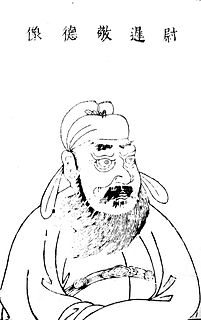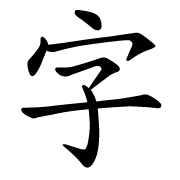
Wei Zheng (580–643), courtesy name Xuancheng, posthumously known as Duke Wenzhen of Zheng, was a Chinese statesman and historian. He served as a chancellor of the Tang dynasty for about 13 years during the reign of Emperor Taizong. He was also the lead editor of the official history of the Sui dynasty, the Book of Sui, which was composed in 636.

Yuchi Gong (尉遲恭) or Yuchi Rong (尉遲融) (585–658), courtesy name Jingde (敬德), also known by his posthumous name Duke Zhongwu of E, was a Chinese general who lived in the early Tang dynasty. Yuchi Jingde and another general Qin Shubao are worshipped as door gods in Chinese folk religion.
Illig Qaghan, later Tang posthumous title Prince Huang of Guiyi (歸義荒王/归义荒王), was the last qaghan of the Eastern Turkic Khaganate.
Empress Xiao, formally Empress Min, was an empress of the Chinese Sui Dynasty. Her husband was Emperor Yang of Sui.
Liu Wuzhou was a rebel leader who rose against the rule of the Chinese dynasty Sui Dynasty late in the dynasty's history, and he took imperial style—although it was not completely clear whether the title he took was khan or tianzi. He was initially only able to take control of modern northern Shanxi and parts of central Inner Mongolia, but after Li Yuan established Tang Dynasty at Chang'an as its Emperor Gaozu in 618, he, with support from Eastern Tujue, briefly captured Li Yuan's initial power base of Taiyuan in 619, posing a major threat to Li Yuan's rule. In 620, Li Yuan's son Li Shimin counterattacked, and not only recaptured Taiyuan but further captured Liu's power base Mayi, forcing Liu to flee to Eastern Tujue. When Liu subsequently tried to flee back to Mayi, Eastern Tujue executed him.
Liang Shidu (梁師都) was an agrarian leader who rebelled against the rule of the Chinese dynasty Sui Dynasty near the end of the reign of Emperor Yang of Sui. He, claiming the title of Emperor of Liang with the aid from Eastern Turkic Khaganate retained the modern northern Shaanxi and western Inner Mongolia region for over a decade, but was gradually weakened by attacks from Tang Dynasty, whose founding emperor Emperor Gaozu and successor Emperor Taizong had eliminated the rival contenders for power one by one, leaving Liang isolated. In 628, with the Eastern Turks in internal turmoil and unable to come to his aid, Emperor Taizong launched another attack on Liang. Liang's cousin Liang Luoren (梁洛仁) assassinated him and surrendered, completing Tang's drive to reunite China after Sui's collapse.
Li Jiancheng (Chinese: 李建成; pinyin: Lǐ Jiànchéng; 589 – July 2, 626, formally Crown Prince Yin, nickname Pishamen, was the first crown prince of the Chinese dynasty Tang Dynasty. He was the oldest son of the founding emperor Emperor Gaozu and the crown prince after the founding of the dynasty in 618. Li Jiancheng was murdered by his younger brother, Li Shimin, the Prince of Qin during Xuanwu Gate indident in 626. All of Li Jiancheng's sons were executed and excluded from imperial clan. After Li Shimin took the throne, Li Jiancheng was posthumously created the Prince of Xi. Later, he was buried with ceremonies due an imperial prince. In 642, Li Jiancheng's crown prince title was restored as the crown Prince of Yin.
Pei Ju (547-627), birth name Pei Shiju, courtesy name Hongda, formally Duke Jing of Anyi, was a statesman who lived in the Sui and Tang dynasties, briefly serving as a chancellor during the reign of Emperor Gaozu of Tang. He was praised by traditional Chinese historians for his ability and lack of corruption, but blamed for flattering Emperor Yang of Sui and practically directly contributing to Sui's downfall by encouraging many external military campaigns that drained Sui's resources. Modern historians have questioned these assessments: Arthur F. Wright labelled the latter judgement in the Zizhi tongjian a "particularly blatant piece of editorializing" and "absurd ... beyond doubt".
Li Daozong (603?-656?), courtesy name Chengfan (承範), was an imperial prince of the Chinese dynasty Tang Dynasty. He was a cousin of Emperor Taizong, and in Emperor Taizong's reign commanded forces in campaigns against Eastern Tujue, Tuyuhun, Goguryeo, and Xueyantuo. In 653, during the reign of Emperor Taizong's son Emperor Gaozong, Li Daozong offended Emperor Gaozong's uncle, the powerful chancellor Zhangsun Wuji, and Zhangsun exiled him to Xiang Prefecture, on accusation that he associated with the treasonous Fang Yi'ai (房遺愛). Li Daozong died on the way to exile.
Wen Dalin (575–637), courtesy name Yanbo, better known as Wen Yanbo, posthumously known as Duke Gong of Yu, was a Chinese official who lived in the early Tang dynasty. He was a key advisor to the Tang dynasty's founding emperor, Emperor Gaozu, and served as a chancellor during the reign of Gaozu's successor, Emperor Taizong. He was captured by the Göktürks and lived among them for years. After he was freed, he drew on his experiences to provide advice to Emperor Taizong on the Tang Empire's policies towards the Göktürks.

Emperor Taizong of Tang, the second emperor of Tang China faced challenges throughout his reign from Tang's western neighbor, the state of Tuyuhun, whose Busabuo Khan Murong Fuyun constantly challenged Chinese authority in the border regions. In 634, Emperor Taizong launched a major attack, commanded by the major general Li Jing, against Tuyuhun, dealing Tuyuhun forces heavy defeats and causing Murong Fuyun's subordinates to assassinate him in 635. Tuyuhun, thus weakened, no longer remained a major power in the region, and while Tang, ironically, played the role of protector for Murong Fuyun's son, the Gandou Khan Murong Shun, and grandson, the Ledou Khan Murong Nuohebo, Tuyuhun was never able to recover, particularly with its southwestern neighbor, the Tibetan Empire, constantly attacking it. By 672, during the reign of Emperor Taizong's son Emperor Gaozong of Tang, Tang was forced to move Tuyuhun remnants into its own territory, ending Tuyuhun.
Emperor Taizong of Tang, the second emperor of Chinese dynasty Tang Dynasty, early in his reign, had allied with Xueyantuo, a vassal of the powerful Eastern Tujue (Göktürk) Khanate, against Eastern Tujue, who Tang defeated in 630. Upon Eastern Tujue's defeat, Xueyantuo's Zhenzhu Khan Yi'nan took over Eastern Tujue's former territory, and while he was formally submissive to Tang, he was expanding his own strength. When Emperor Taizong tried to restore Eastern Tujue in 639 under the Qilibi Khan Ashina Simo to counteract the rise of Xueyantuo power, Xueyantuo engaged in multiple battles with the newly restored Eastern Tujue, in order to prevent this return. The major Tang general Li Shiji temporarily came to protect Eastern Tujue against Xueyantuo and defeated the Xueyantuo forces in 641. But in 644, with Emperor Taizong occupied with a campaign against Goguryeo, Xueyantuo forces launched a new campaign, defeated Eastern Tujue, forcing Ashina Simo to flee back to Tang. Subsequently, Goguryeo sought aid from Xueyantuo, but Yi'nan avoided further conflict, wanting to avoid direct battle with Tang. After Yi'nan's death in 645, however, his son, the Duomi Khan Bazhuo began heavily battling Tang forces. In 646, Tang forces counterattacked, and after they defeated Bazhuo, Xueyantuo's vassal Huige rose and killed him. His cousin, the Yitewushi Khan Duomozhi, surrendered to Tang forces, ending Xueyantuo.
Qilibi Khan, personal name Ashina Simo (阿史那思摩), (also known as Li Simo, full regal title Yiminishuqilibi Khagan, Tang noble title Prince of Huaihua, was a member of the Eastern Tujue royal house who was given the title of Khan of Eastern Tujue for several years, as a vassal of the Chinese Tang Dynasty.
Zhenzhu Khan, personal name Yi'nan (夷男), full regal title Zhenzhupiqie Khan (真珠毗伽可汗), was a khan of Xueyantuo, under whom Xueyantuo rose from being a vassal of Eastern Tujue to a mighty khanate ruling over northern/central Asia. During his reign, Xueyantuo largely aligned with China's Tang Dynasty, even though the two states were at odds at times, with the most serious dispute involving Tang's attempt to reestablish Eastern Tujue as a vassal state under the Qilibi Khan Ashina Simo—an attempt that eventually failed due to frequent incursions by Yi'nan's army against Ashina Simo. Throughout Yi'nan's reign, Xueyantuo remained powerful despite Tang attempts to curb its power, but after Yi'nan's death, a succession dispute between his sons, Bazhuo and Yemang (曳莽), led to Bazhuo's killing of Yemang and subsequent internal unrest. Further, Bazhuo attacked Tang, resulting in a major Tang retaliation campaign that, along with a revolt by the Huige, led to Xueyantuo's destruction in 646.
Kurshad or Ashina Jiesheshuai was a member of the Ashina clan of the Eastern Turkic Khaganate and general (Zhonglangjiang) of the Tang dynasty.
Ji or Jicheng was an ancient city in northern China, which has become the longest continuously inhabited section of modern Beijing. Historical mention of Ji dates to the founding of the Zhou Dynasty in about 1045 BC. Archaeological finds in southwestern Beijing where Ji was believed to be located date to the Spring and Autumn period. The city of Ji served as the capital of the ancient states of Ji and Yan until the unification of China by the Qin Dynasty in 221 BC. Thereafter, the city was a prefectural capital for Youzhou through the Han Dynasty, Three Kingdoms, Western Jin Dynasty, Sixteen Kingdoms, Northern Dynasties, and Sui Dynasty. With the creation of a Jizhou (蓟州) during the Tang Dynasty in what is now Tianjin Municipality, the city of Ji took on the name Youzhou. Youzhou was one of the Sixteen Prefectures ceded to the Khitans during the Five Dynasties. The city then became the southern capital of the Liao Dynasty and then main capital of the Jin Dynasty (1115-1234). In the 13th Century, Kublai Khan built a new capital city for the Yuan Dynasty adjacent to Ji to the north. The old city of Ji became a suburb to Dadu. In the Ming Dynasty, the old and new cities were merged by Beijing's Ming-era city wall.

Zhang Gongjin, courtesy name Hongshen, titled Duke of Tan, was an official and general during the Tang Dynasty of China. He played an important role in the Xuanwu Gate Incident in 626 which helped Emperor Taizong obtained the crown. He was a key general of Tang Dynasty during the campaign against Illig Qaghan of Tujue. Because of his contributions, he was listed as one of 24 founding officials of Tang Dynasty honored on the Lingyan Pavilion.












